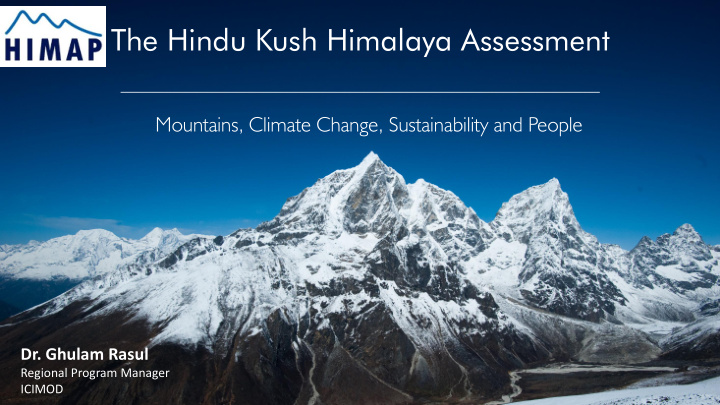



The Hindu Kush Himalaya Assessment Mountains, Climate Change, Sustainability and People Dr. Ghulam Rasul Regional Program Manager ICIMOD
The he Hin indu du Kush sh Him imalaya alaya Global asset for food, energy, water, carbon, and cultural and biological diversity
8 countries • 240 million people • in the HKH mountains and hills 1.65 billion people • downstream
>350 people and growing: 210 authors (30% women; 80% from the region), 125 external HI HIMAP P 1 st st reviewers, 20 Review Editors Ass ssess ssme ment nt Four Writeshops: Jan, June and Sept 2016 and Aug 2017 Process cess To be published by Springer Nature, fully Open Access, end 2018
HKH will warm more compared to global mean and more rapidly at higher elevations Even n 1.5 5 Degree ees s is is T Too o Hot for the Ho he HK HKH 2.1 ± 0.1˚C (PI) in a 1.5 degree world and amplified 2.5 ± 1.5˚ C by 2100 relative to 1976-2005 by Elevation (RCP 4.5) Dependent 5.5 ± 1.5˚ C by 2100 relative to 1976-2005 at Warming current emission pathways For areas above 2,000m, if 1.5˚C EOC then: Source: HIMAP climate change – Karakoram 2.2 ± 0.4˚C chapter and Kraaijenbrink et al. 2017, Nature – Central Himalayas (2.0 ± 0.5˚C) – Southeast Himalayas (2.0 ± 0.5˚C)
Snow covered areas and snow volumes will In a 1.5˚ C world, decrease and snowline elevations will rise; glaciers in the HKH will lose 36% Snow melt induced run-off peak will be volume by 2100 stronger and occur earlier in the year A 2˚ C global warming scenario implies a regional warming of around 2.7˚ C and a 49% loss of ice volume Source: HIMAP climate change and cryosphere chapters and Kraaijenbrink et al. 2017, Nature
Source: HIMAP climate change and cryosphere chapters and Kraaijenbrink et al. 2017, Nature International Centre for Integrated Mountain Development Kathmandu, Nepal
Not running out of water, but… Greater impact for those living closer to glaciers Climate change is expected to drive consistent increases in total runoff of the Indus, Ganges and Brahmaputra Indus: increased glacier melt, then declines after mid-century Ganges/Brahmaputra: increased runoff due mainly to precipitation Changing precipitation and flow patterns – more floods and droughts; high uncertainty Climate change also likely to affect groundwater, especially springs in the mid-hills of the HKH, but limited evidence. Contribution to total flow by (a) glacial melt, (b) snowmelt, and (c) rainfall-runoff for major streams during the reference period of 1998 – 2007. Line thickness indicates the average discharge during the reference period. Source: Lutz et al. (2014)
Disaster risk is increasing Floods, droughts, landslides, glacial lake outburst floods One-third of disasters are floods, many crossing national borders More than 1 billion people at risk of exposure to increasing frequency and intensity of natural hazards Women more susceptible to natural disasters then men
Fl Flood od ma magni gnitude tude ma may y double ble RCP 4.5 Mean relative change in 50 Average river flow will increase year return period of floods by EoC in upper river basins: 50% in upper Indus 30% – 40% in upper Ganges 25% – 50% in upper Brahmaputra RCP 8.5 Intensities of ‘once in 50 years’ flood events will increase: 40% – 110% in upstream areas 115% – 150% in downstream areas Source: Wijngaard et al. 2017, PLOS One
Key Findings: Adaptation Climate change adaptation policies and practices must intensify in the HKH — and become transformative. Institutional capacity on adaptation urgently needs to increase until it fits to purpose at each level of governance. Policy and practice should focus more on the links among climate change adaptation, disaster risk reduction, and the Sustainable Development Goals .
Key Findings: Adaptation Local-level autonomous responses to climate variability and extreme events must be studied systematically. Such responses need to become a source of critical, practice-based feedback to adaptation planning at higher governance levels.
Thank You
Recommend
More recommend